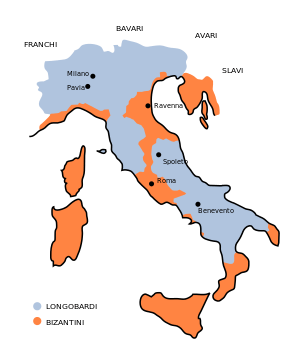Langobardia Minor
Langobardia Minor was the name that, in early Middle Ages, was given to the Lombard dominion in central-southern Italy, corresponding to the duchies of Spoleto and Benevento. After the conquest of the Lombard kingdom by Charlemagne in 774 it remained under Lombard control.
Once in Italy through the Friuli in 568, the Lombards tore from the Byzantines a large part of land south of the Alps, but didn't constitute, at least initially, a uniform and contiguous domain. The submissive lands were grouped, in the terminology of the time, in two important areas: Langobardia Major, from the Alps to today's Tuscany, and Langobardia Minor which included the possessions south of the Byzantine territories (which in that last part of the 6th century stretched from Rome to Ravenna through current Umbria and Marche). The Exarchate of Ravenna was connected to Rome through the "Byzantine corridor", which went through Orvieto, Chiusi and Perugia and separated Langobardia Minor from Major.
While Langobardia Major was fragmented and changing in many duchies and Gastalds, Langobardia Minor maintained for the duration of the Lombard kingdom (568–774) a remarkable institutional stability, remaining divided into the two duchies of Spoleto and Benevento. They were formed immediately after Lombard penetration, in the 570s, and the first dukes were Faroald in Spoleto and Zotto in Benevento. In the beginning they included geographically only the inland areas, leaving the Byzantines control of the coastal areas; only later (particularly during the reign of Agilulf, 591–616) Lombard possessions were extended also to the coasts. So became subject to the two duchies the entire Adriatic coast between Byzantine strongholds of Ancona in the north and Otranto in the south; the Ionian and the Tyrrhenian, however, only partially fell under the authority of the duke of Benevento, which was never able to permanently occupy Naples, the Salento and the tip of Calabria (south of Cosenza and Crotone), and of course, Rome and its suburbs.
Sources
- Paul Deacon, Historia Langobardorum (Storia dei Longobardi, Lorenzo Valla/Mondadori, Milan 1992)
